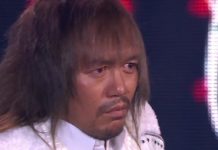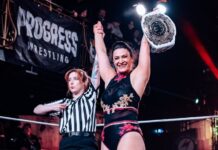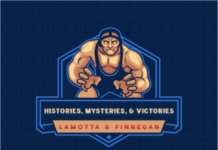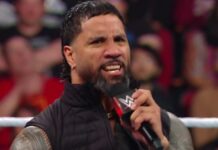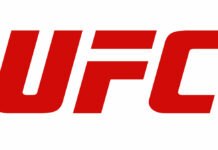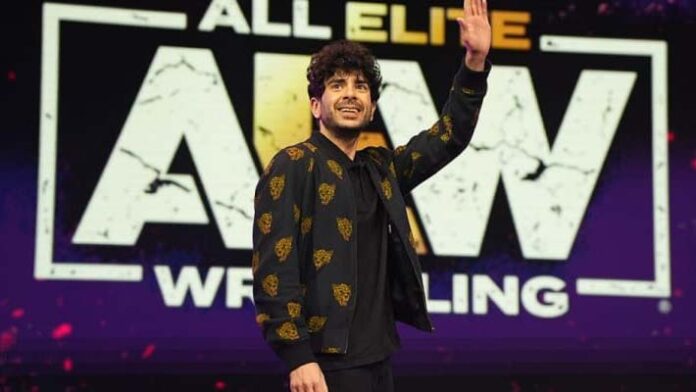
Through the annals of wrestling history, plenty of beautifully crafted stories have been told in and out of the squared circle. In a perfect combination of storytelling, emotion, and violence, many great wrestling angles have captivated the minds of generations of wrestling fans.
These stories can be told through various mediums as well. Stories like the rise and fall of Evolution, or the very evolution of Becky Lynch becoming “The Man”, speaks to the sports entertainment medium. However, sports-based stories can also be told; from Omega vs. Okada or Flair vs. Steamboat.
However, when it comes to long-term, in-depth storytelling, there is one company that isn’t really known for it in their short history: All Elite Wrestling.
And that isn’t to say the promotion hasn’t had their share of long-term gems. “Hangman” vs. The Elite, MJF vs. C.M. Punk, Moxley vs. The Inner Circle — examples of great storytelling do exist. However, when we think of most past and present angles, is there a “big” storyline that AEW can point to in their history much like their competitor can? A story that expands across demographics, and attracts new (or once jaded) viewers to the product?
Furthermore, we must ask the question, do they even need it?
Before we answer this question, let’s get some history…
What History Says
When Hulk Hogan was revealed as the third member of the nWo on July 7th, 1996, it shook the foundation of the pro wrestling world. Quite frankly, there is little chance a swerve could exist in the modern day era. The nWo angle itself would run for many years in WCW and take on different forms (to sometimes exhausting levels). This alone would keep WCW ahead in the ratings war for some time.
One could ask if wrestling storylines have the same effect as they do in the modern craft. Wresting fans are a bit smarter now, and achieving the high bar in which fans have placed on the current product can be often unreachable. This is one of the reasons why many older fans reflect fondly on wrestling’s past over the present.
Most well-known and accepted “great” wrestling angles, usually exist in this past with few exceptions. In no particular order, a shortlist of this includes:
-Austin vs. McMahon
-Sting vs. the nWo
-Lawler vs. Kaufman
-Mankind vs. The Undertaker
-Evolution (rise and fall)
-Junkyard Dog vs. The Freebirds
-Okada vs. Tanahashi
-“Hangman” Adam Page vs. The Elite
-Flair vs. Steamboat
-Flair vs. Rhodes
-Jericho vs. HBK
-The Rise of Tetsuya Naito
-Gargano vs. Ciampa
The list goes on and on. History is full of great “big” wrestling angles that lured viewers into tuning in to “must-see” stories; and in regards to storytelling, today’s modern product seems to pale in comparison to wrestling’s past. Well, with one exception:
The Bloodline.
A Modern Masterpiece

Many consider WWE’s Bloodline angle to be the best story in WWE history. Spanning over 3 years, and still ongoing, it combines the elements needed in every well-told story:
-Compelling characters
-Cohesive Plot
-Motivations
-Conflict
-Defined Protagonists/Antagonists
If you look at any of the great wrestling angles in history, you’re going to have these five elements. In many ways, booking good professional wrestling stories is not difficult. It’s just the matter of finding the right characters with the right motivations woven into an intriguing plot.
When it comes to The Bloodline, you have all of these elements in place.
However, I’m going to pose a question all of the readers now: Would WWE be in a current state of ascension without The Bloodline angle?
Take the story out entirely. Look at the angles over the last few years aside from this story — do you still tune in?
If Reigns is taking on random opponents, Sami Zayn never ascends to top face status, and The Usos are largely lost in the tag team division. Are you still watching Raw as “can’t miss” television?
Accentuate the Positives (Hide the Negatives)
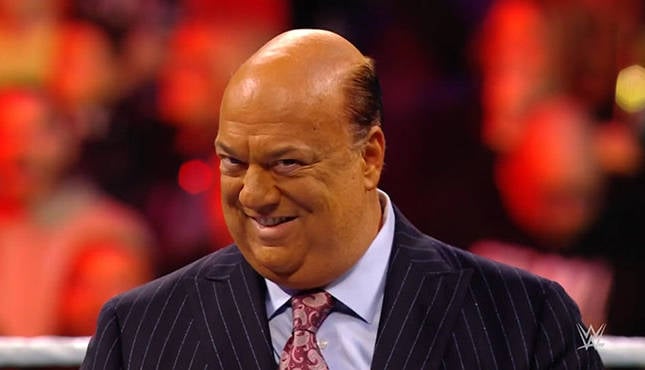
In the 2004 documentary, Rise and Fall of ECW, Paul Heyman said it himself regarding his philosophy on booking Extreme Championship Wrestling during the 90s.
“There was no way to compete with the production values that Ted Turner or Vince McMahon could afford. They had million dollar, multi-million dollar budgets! We didn’t! We had a very simple philosophy when it came to our wrestlers: accentuate the positives, hide the negatives. Well, the negative is that we don’t have the budget to compete with WWE and-and WCW on lighting and pyro… why go there? Hide it! Accentuate the positives: best interviews, most action, wildest brawls, best wrestling, highest-flying cruiserweights, all these different things that we could do better than everybody else, we’re going to accentuate that. Why be second best at anything? Why not say “Screw the lights, screw the pyro, here it is, down and dirty; it’s all about the presentation. It’s all about the audience’s participation in the show.” – Paul Heyman
The Attitude Era is known to the the pinnacle of pro wrestling popularity. But if we examine the stories — we don’t get a heck of a lot of great angles aside from a select few. We all know Austin vs. McMahon, D-X vs. The World, and The Rock vs. Austin. But remember all of the failed stories from that era?
The Unholy Alliance, Rikishi and “I did it for The Rock”, Shamrock’s failed push, “heel” Jim Ross, Bossman vs. the Big Show, Road Warrior Hawk’s depression, — and of course “It’s me, Austin!” — all mostly hot garbage. From Val Venis vs. Kai En Tai, to Mae Young’s “hand”; there’s plenty more legitimate Wrestlecrap from this era we don’t have time for.
So what’s the point? Wrestling is full of bad to mediocre angles over its history.
The point is that if we don’t have Austin/McMahon, Kane vs. Undertaker, the rise of the People’s Champ, E&C vs. Hardy Boyz vs. Dudley Boyz, or Mick Foley winning the WWF Championship, I again post the same question above with The Bloodline:
Do we even tune in?
These stories are what compelled viewers to go out of their way to watch the WWF product during this time. If Austin was just in another random angle, and not feuding with his boss, would the Attitude Era be remotely as successful as it was? Like Heyman said, WWE has historically hidden it’s negatives (usually weak in-ring action) in order to present larger storylines as their positives.
Does AEW Need a “Big” Storyline?
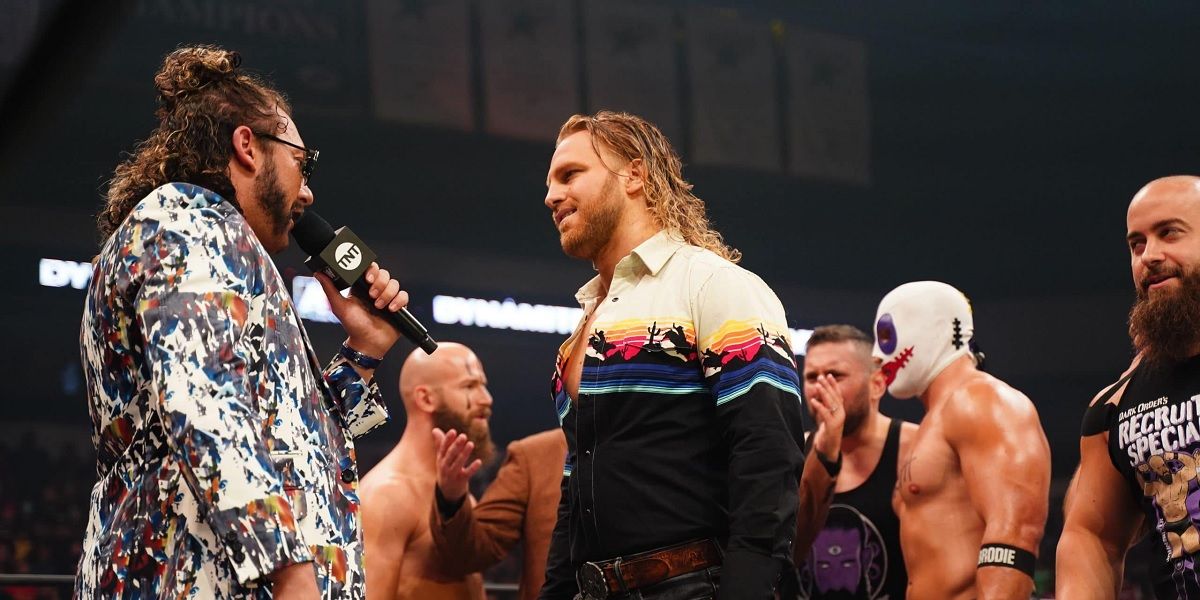
As mentioned, AEW isn’t really known for their storytelling. From an in-ring standpoint, they stand alone as #1 in the world without question. However, most of the storytelling you get will come in appetizer-sized chunks. Yes, MJF vs. Danielson was great. Orange Cassidy’s current run as International Champion is great. If we look at the past (sans Hangman vs. The Elite): Moxley/Omega, Deeb/Shida, Baker/Rosa, Death Triangle/The Elite, Cody vs. Jericho — all great in their own way. But usually all fairly short feuds, and nothing that set the wrestling world on fire.
But let’s say AEW tries to craft that big angle. The one casual fans even tune in for — I pose this question for the reader:
Does it risk turning AEW into “WWE-lite”? For such deep and intriguing angles, you sometimes need a dedicated slot of time to fill out segments with lengthy promos and drama. If AEW were to craft a Bloodline-like story, does it spit in the face of what made AEW popular with its fanbase in the first place?
As Heyman put it, why try to compete with the production and branding of WWE? Why not instead accentuate the positives you do have? Because if AEW simply followed the casual fan formula, will they truly exist as an alternative anymore?
Crafting AEW’s “Big Storyline”

Let’s craft a “big” AEW storyline. A story that spans months; maybe even a year, and captures the attention of the wrestling world — hardcore and casual fans alike.
What does it look like? Who are the characters, and what are their motivations? The current MJF/Adam Cole saga has potential — especially if it ends in a successful tag team championship run and a double turn (MJF as a face? It’s possible…).
The BCC vs. The Elite and Orange Cassidy’s historic run both look to be wrapping up sooner than later. The Outcasts dominance is starting to lose its fizzle. The House of Black vs. Andrade El Idolo has mostly been forgettable.
There’s a blank canvas on the horizon. Could Don Callis be the one to fill it? Remember, compelling characters, fluid motivations, and a well-formed plot. Here’s what I would do: Warning: Ridiculous fantasy booking ahead. Skip this if desired.
–
Don Callis is a heat magnet. Alongside Konosuke Takeshita (who looks like a bad-ass foreign movie villain now), the family expands. Does Chris Jericho join?
No. Jericho ultimately decides to stay with the J.A.S. only for Sammy Guevara to be the one to turn on Jericho, kick him, 2.0, and Jake Hager out — and start his own stable. This would be similar to Tetsuya Naito’s Los Ingobernables de Japon group — sort of a younger, renegade stable.
But Guevara’s new stable is just an appetizer for another feud. Moving on…
After Hobbs destroys QT Marshall (rightfully so), he joins forces with a more able manager in Don Callis (after proving himself by injuring Kenny Omega). “Hollywood” Jack Perry also joins the family for the opportunity of success. However, the family needs a tag team. On a random episode of Dynamite, Callis teases that he has hired “guns” joining the family soon. The swerve is that this would be The Gunn Club.
Later, in a six-man match between Takeshita, Hobbs and Perry vs. The Elite (Bucks and Page), the stage is set for the reveal. After The Elite have Takeshita all but ready to take a Buckshot Lariat something incredible happens — The Young Bucks dish out a double superkick to Page, leading to a Senton Bomb from Takeshita and a pinfall. The Young Bucks have joined the Don Callis family.
The Young Bucks have turned their backs on The Elite. This isn’t like when they turned on Jon Moxley in 2021 — they are turning their backs on the entire “BTE” fanbase.
With Omega and Page now seemingly alone and against the world, they receive help in an unexpected place. After weeks of being outnumbered by the Callis family, Callis will soon introduce his new family member — familiar music hits — It’s “Cult of Personality”, bringing out none other than C.M. Punk. Don is confused, as Punk isn’t who he intended to bring out, and Punk isn’t there to join the family, but team up with Omega and Page.
With the yet unnamed added member of the Callis family seemingly taken out by Punk, he now knows something nobody else does — who is this unknown member, and has Punk made him a better offer? Who this person is and what side they are on is subject to speculation for weeks.
FTR would likely end up joining the fight as well on the side of the good guys as this leaves room for younger tag teams to feud for gold (Acclaimed/Bullet Club Gold feud anyone?)
How this ends is anyone’s guess, but a story like this accomplishes episodic intrigue; which is paramount to any well-told wrestling story. Taking the real-life conflict between Punk and The Elite and working it into a surprising angle would be not only best for business, but a show of unity overall. This “drip, drip, drip” of something new to a a big angle is something AEW is somewhat missing right now.
(end fantasy booking)
But even a story like this — is it necessary, and would it work? Does it fit the mold of AEW programming and who they are as a company? Furthermore, what would you do to book a “big” AEW storyline?
Should AEW Ever Change Their Philosophy?
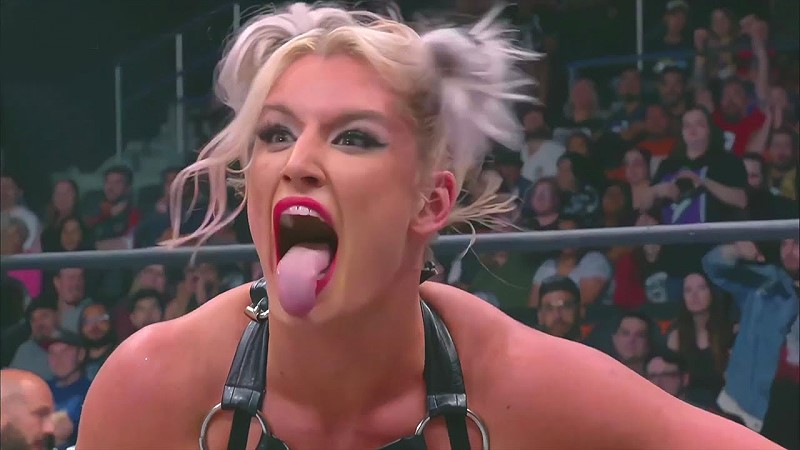
If it’s the direction of the women’s division; yes, AEW should definitely change course. It’s been four years, and we can’t seem to get consistent and competent booking in the women’s division.
I digress…
But an episodic storyline in the vein of a Bloodline angle in AEW would potentially hide some positives; something Heyman advocated against in ECW. Part of what attracts the hardcore base of AEW fans is that great wrestling can break out at anytime, for any reason.
Building a time-consuming story that takes up a large chunk of the show may leave other deserving talents off-screen. Perhaps there is a slight ratings boost, but would this turn off the loyal base of AEW fans that are there for the sports-based product as a whole? And if you lose your loyal base of fans, could you count on newer casual fans to keep the product hoisted?
At the end of the day, AEW is a successful wrestling brand by all definitions. Consistent TV ratings, new shows, and coming network deals with Warner Media conclude that the product is doing well overall.
But we live in a society where everything is compared to what the head of the table is eating. How can any wresting product ever stand out if the formula is just to sort of be like WWE?
At the end of the day, I’m not convinced AEW even needs a “big” storyline even if it were a highly intriguing one. Part of what makes AEW great is that they have their own formula. A high emphasis on in-ring action, with a limited amount of “sports entertainment”. This is only helped out by a new Collision show that harkens back to a old-school approach to their weekly broadcasts.
While many fans may clamor for a WWE-like approach to AEW’s storytelling, must mustn’t forget that Tony Khan’s Indies/Puro/Mainstream hybrid approach is what had made AEW the cemented #2 wrestling company in the world in the first place. Perhaps it is a product to be appreciated, rather than “corrected”.
What do you think? Share your thoughts, opinions, feedback, and anything else that was raised on Twitter @PWMania and Facebook.com/PWMania.

